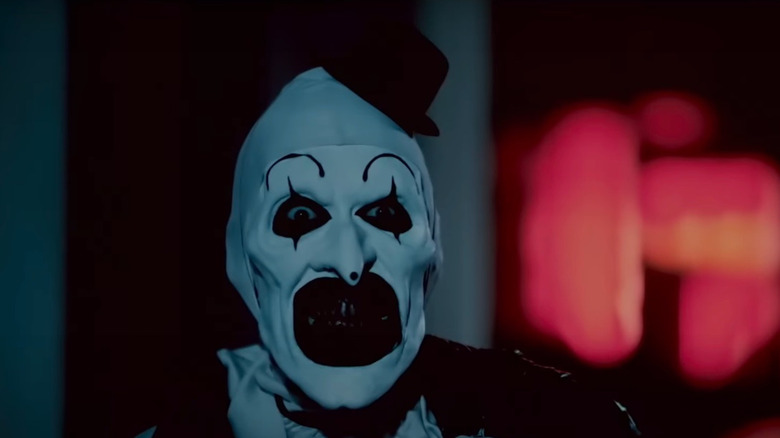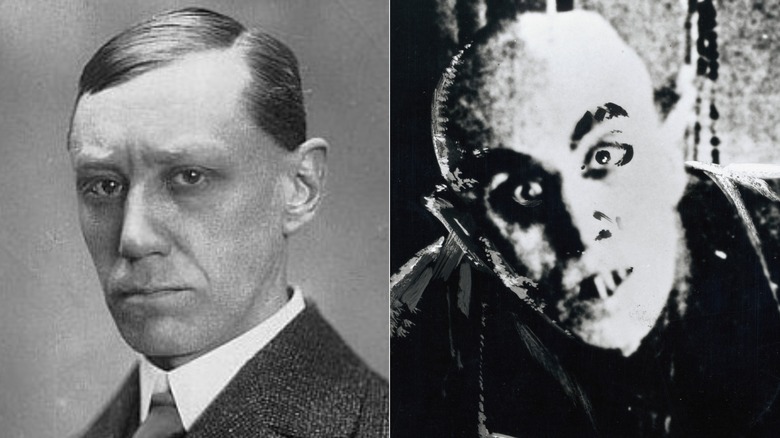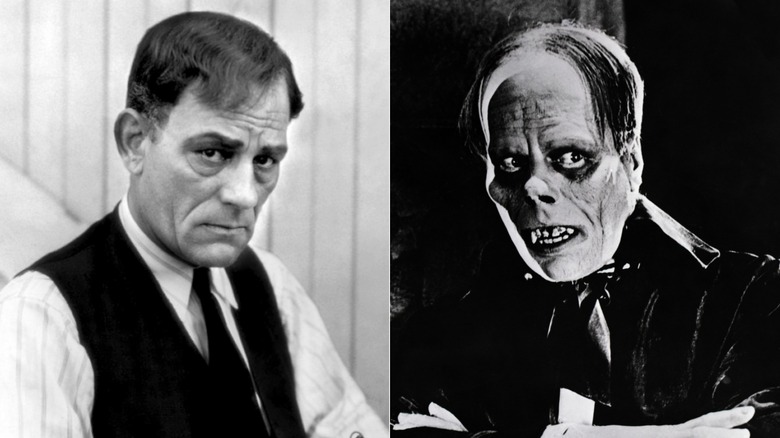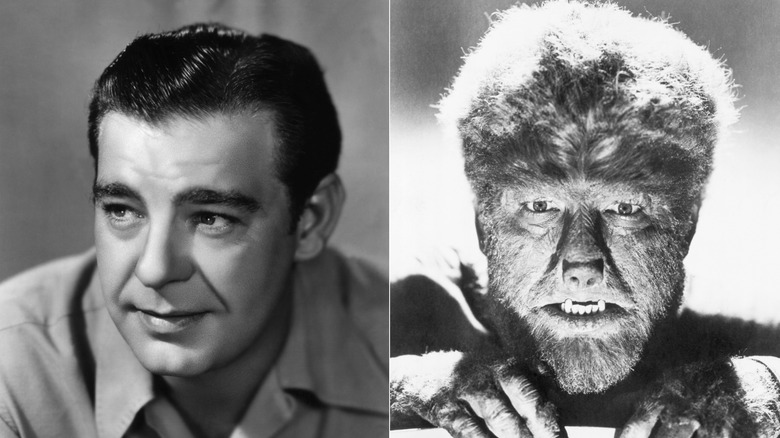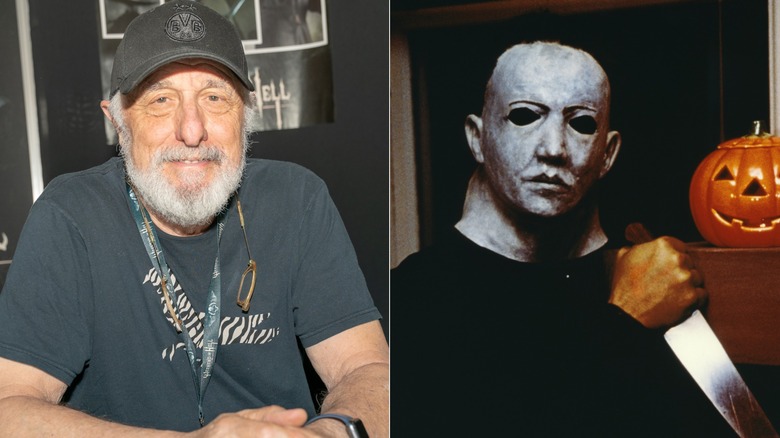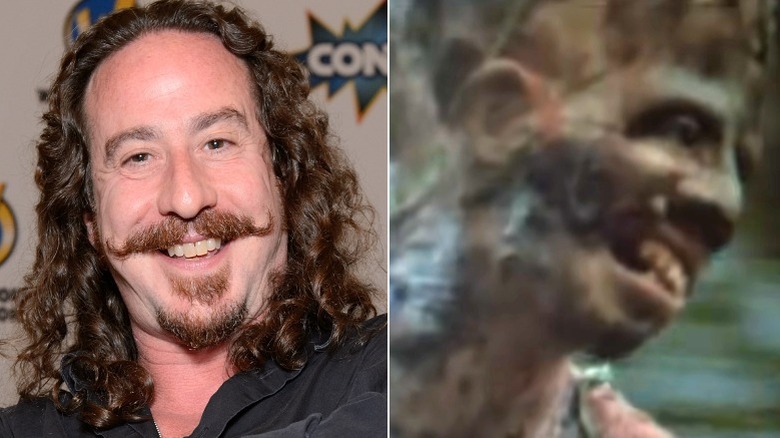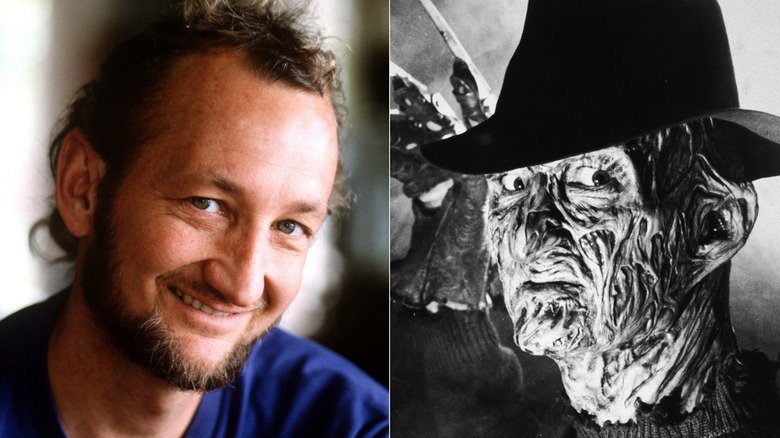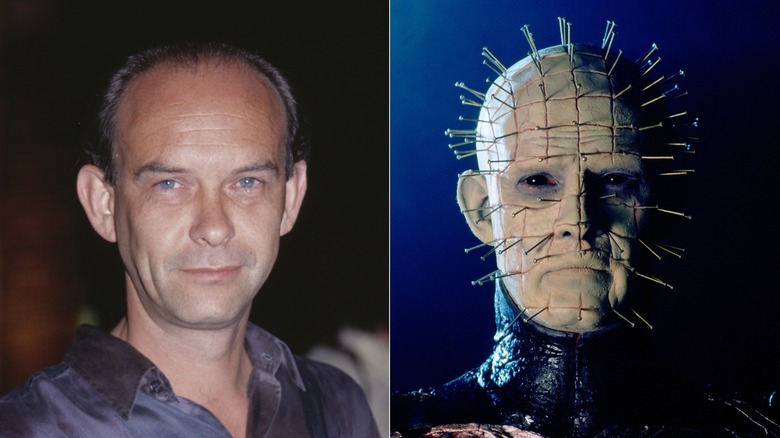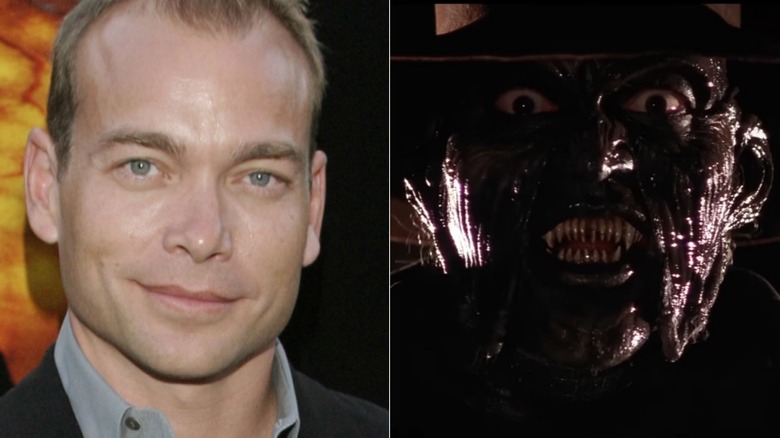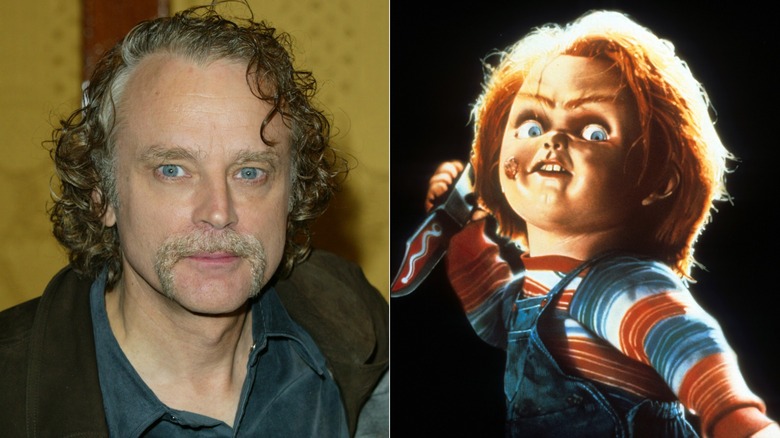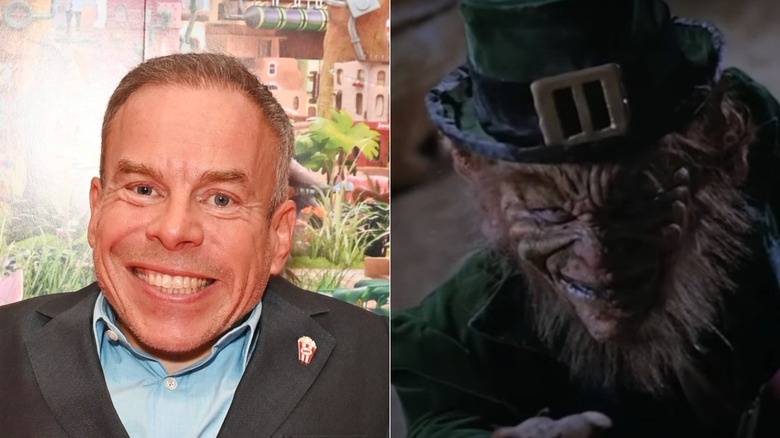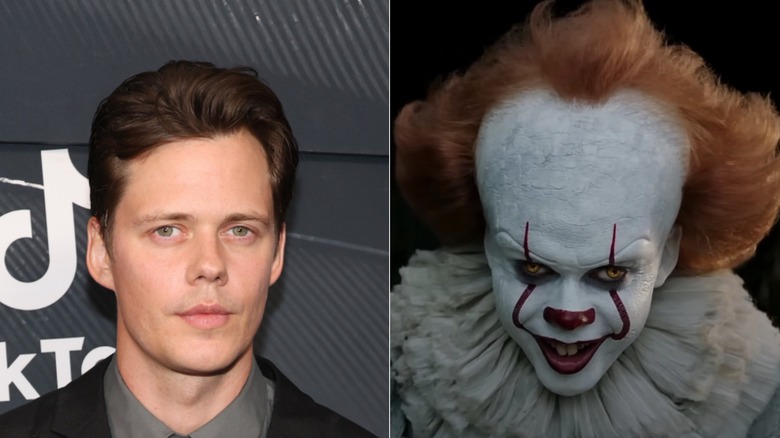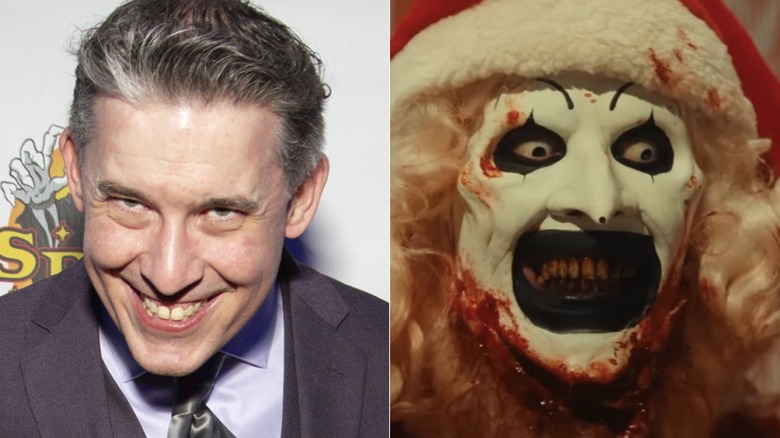Horror Movie Actors Who Are Unrecognizable In Real Life
Horror movies have been a part of the entertainment landscape since the earliest days of cinema. Since then, moviegoers have relished the experience of getting terrified, and horror continues to thrive. Within the ever-popular and constantly evolving horror genre, a number of characters have become established that have taken on near-mythic proportions, as the murderous exploits of Freddy, Jason, and their ilk spawn countless sequels. Meanwhile, recent additions such as Art the Clown from the "Terrifier" franchise have proven there remains a grisly thirst for slasher movies.
Often, the actors who portray these characters are concealed by makeup, prosthetics, or masks. That has led to a somewhat ironic scenario in which fans of film franchises such as "A Nightmare on Elm Street," "Halloween," and "Friday the 13th" become intensely familiar with the characters responsible for all those on-screen homicides — while having no clue what the actors who play them actually look like.
So who are these unsung Hollywood heroes of murder and mayhem? To find out, read on for a rundown of horror movie actors who are unrecognizable in real life.
Max Schreck as Count Orlok in Nosferatu
German director F.W. Murnau borrowed liberally from Bram Stoker's "Dracula" for his 1922 horror classic "Nosferatu: A Symphony of Horror." How liberally? The company that produced the movie, Prana Film, declared bankruptcy shortly after its release to avoid paying any copyright infringement costs to Stoker's widow. While the storyline is pretty much identical, Murnau's German Expressionist film introduced a different vampire, Count Orlok. The character was portrayed by Max Schreck (whose surname is German for "terror"), who was rendered unrecognizable with a bald head, pointed ears, prominent fangs, and spider-like fingers from which extended lengthy claws.
Schreck's performance so chilled moviegoers of the era that rumors emerged claiming he actually was a vampire, discovered by Murnau in the Carpathian mountains and enlisted to appear on film. Oddly, there was some strange evidence supporting that, in that Schreck was never seen on the set out of costume and, because he was reportedly a method actor, never broke character throughout filming. That rumor, in fact, formed the basis for the fanciful 2000 film "Shadow of the Vampire," in which Willem Dafoe portrayed Schreck as a legit vampire.
While much about Schreck has been lost to the shifting sands of time, the vampire rumor was, of course, complete nonsense. By the time of his death in 1936, Schreck had appeared in more than 50 films and portrayed in excess of 700 roles onstage.
Lon Chaney as the Phantom in The Phantom of the Opera
In the early days of Hollywood, Lon Chaney was known as "the Man of a Thousand Faces" for his uncanny ability to use creative makeup and his own physicality to transform into characters that rendered him unrecognizable. Of his various screen roles, Chaney is best remembered for 1925's "The Phantom of the Opera." To portray the film's hideously deformed composer, Chaney employed an array of makeup tricks, including elevating his cheekbones to give him a more skeletal appearance, adding a set of jagged faux teeth, and concealing wires beneath putty to pull his nostrils upward.
"It's an art, not magic," Chaney said of his "Phantom" makeup, as quoted in a feature about the film for American Cinematographer. "In 'The Phantom of the Opera,' people exclaimed at my weird makeup. I achieved the Death's head of that role without wearing a mask. It was the use of paints in the right shades and the right places — not the obvious parts of the face — which gave the complete illusion of horror."
According to Chaney, he was able to adapt what he'd already been doing in theater for the emerging medium of cinema. "My experiments as a stage manager, which were wide and varied before I jumped into films, taught me much about lighting effects on the actor's face and the minor tricks of deception," he explained. "It's all a matter of combining paints and lights to form the right illusion."
Lon Chaney Jr. as the werewolf in The Wolf Man
Lon Chaney discouraged his son, Creighton Chaney, from following his path into showbiz. After the elder Chaney's death in 1930, his son began acting in movies, under the name Lon Chaney Jr. He quickly gained a foothold within the horror genre, most notably when he played the title role in the 1941 horror classic "The Wolf Man." Like his father, Chaney was unrecognizable as the werewolf, his face covered with fur while a dog-like snout and teeth completed the illusion.
Chaney — who died in 1973 — went on to appear in hundreds of movies and TV series, playing such horror icons as Frankenstein's monster, Count Dracula, and the Mummy. He also revived the Wolf Man in various films, ranging from "Frankenstein Meets the Wolf Man" to "Abbott and Costello Meet Frankenstein."
More than two decades later, the film remained a high point in his career. "Of all the monster movies, my favorite is 'The Wolf Man' because he is the most sensible, the one who is closest to the truth and also the one who is closest to an actual historical fact," explained Chaney in a 1965 interview with The Tennessean. "I still watch 'The Wolf Man' when I get a chance. I have sort of gotten attached to him."
Nick Castle as Michael Myers in Halloween
Decades before winning her first Oscar, Jamie Lee Curtis gained her scream queen cred in "Halloween," fighting for her life as she fended off masked maniac Michael Myers in the 1978 horror classic. Over the years, in multiple sequels, nine different actors have played the role, all lurking behind a William Shatner-based Capt. Kirk "Star Trek" mask.
For purists, however, Michael Myers will always be Nick Castle, who played the character throughout most of the first movie. (Another actor, Tony Moran, played the character when unmasked in the film.) While appearing at a fan convention, Castle revealed that he'd attended film school with "Halloween" director John Carpenter and happened to drop by the film's set. He decided to hang out in order to witness how the film was made. "And [Carpenter] said, 'Why don't you be this guy. Here's this mask, put it on and you'll walk around, kill people, and you'll be here the whole time.' And I went, 'Sounds good,'" Castle recalled of how he came to be cast.
Forty years later, Castle stepped back into the role in 2018's "Halloween," reuniting with O.G. star Curtis. "She came running over, we hugged each other, and she just looked at me and said, 'Is this nuts or what?'" Castle said in an interview with What Culture.
Ari Lehman as Jason Voorhees in Friday 13th
Another slasher-movie icon made his screen debut in 1980, with the premiere of "Friday the 13th." Jason Voorhees, who would in later installments hide his deformed visage behind a hockey goalie's mask while slaughtering horny teenagers at a summer camp, first appears in the franchise as an unmasked child, played by Ari Lehman.
As in the case of Michael Myers, Lehman has not been the only one to play Jason; in fact, he's the first of 10 actors to have portrayed the character in umpteen "Friday the 13th" movies. That said, being the first has given him a special claim on the character, something that Lehman — who's become the frontman in the aptly named heavy metal band First Jason — told Media Mikes, describing his role in creating Jason's now-iconic appearance.
"I worked with the SFX wizard Tom Savini and his assistant Taso Stavrakos on and off for four weeks to create the original mold for the face," Lehman recalled. "After that, script additions called for the character to appear water damaged. I went back to the studio for a few days before we tried it out on the set. Each time it took around four hours to apply the makeup, so if there was a 7:30 a.m. call for cast and crew, we would start applying the mask at 3:30."
Robert Englund as Freddy Krueger in A Nightmare on Elm Street
Making its debut in 1984, "A Nightmare on Elm Street" not only marked the screen debut of scandal-plagued movie star Johnny Depp but also introduced Freddy Krueger, one of the most terrifying villains in horror history. The character — a deceased serial killer, scarred beyond recognition by the fire that killed him — continues to haunt the dreams of his teenage victims, murdering them in their sleep via the razor-sharp talons on his gloved hand.
Behind the horrifying mask is actor Robert Englund, who originated Freddy in the first film and has returned to the role umpteen times in myriad sequels. Jackie Earle Haley stepped into the role for a 2010 remake, while Englund hasn't appeared on film as Freddy since 2003's "Freddy vs. Jason," although he did, more recently, reprise the role in a 2018 episode of ABC sitcom "The Goldbergs."
"I think Freddy Krueger is the logo of the experience that people have, sitting through eight of the movies," Englund told the Daily Beast when asked about the source of the character's enduring popularity with horror fans. "I'm the symbol of that experience, and I get that de facto popularity because of it. Now, the sense of humor — he's got some great lines along the way. And he's also unapologetically evil. I think as a precursor to the sort of politically correct moment in time, Freddy stands out as unapologetically evil. He's an equal-opportunity killer."
Doug Bradley as Pinhead in Hellraiser
In 1987, director Clive Barker unleashed his debut feature, "Hellraiser," in which a mysterious puzzle box conjures up the Cenobites, leather-clad demons with a flair for sadomasochism. The Cenobites' leader was dubbed Pinhead, so named for the numerous nails protruding from his head. As portrayed by Doug Bradley, Pinhead became the franchise's central figure in several "Hellraiser" sequels — although, when seen without all that metal sticking out of his face, Bradley's appearance is almost shockingly normal.
Interviewed by Louder Sound, Bradley recalled how his performance was honed by Barker while filming the first movie. As he noted, Barker kept telling him to "do less," which Bradley initially found frustrating from an acting perspective, pointing out that if he kept minimizing his performance, he'd essentially just be reciting dialogue. Then he realized that minimalism was exactly what the role called for.
"And really what Clive was saying to me was: 'Do exactly that. Do nothing. The makeup is working overtime on your behalf. And by the time your face is 20 feet tall on a movie screen, you don't need to do anything else. And the more you don't sell it, the more you're selling it,'" Bradley said.
Jonathan Breck as the Creeper in Jeepers Creepers
Premiering in 2001, "Jeepers Creepers" thrust a weird new character onto the horror landscape: the Creeper, a demonic entity that chows down on human flesh during a 23-day feeding frenzy that occurs once every 23 years. The character was played by actor Jonathan Breck, who returned to wreak havoc in two sequels: "Jeepers Creepers 2" in 2003 and "Jeepers Creepers III" in 2017. (Another actor, Jarreau Benjamin, played the Creeper in 2022's "Jeepers Creepers: Reborn.")
With his face hidden beneath extensive prosthetics that reportedly took up to seven hours to apply, Breck would never be mistaken for the character when out of makeup. "I must admit I was kind-of disappointed that this was my first big studio movie and you couldn't see my face!" Breck joked in an interview with Neil Young's Film Lounge.
While promoting the third film, Breck ruminated on what made the character so popular with horror fans. "I think the reason it appeals to people is because people don't take the time to make original monster movies anymore," he told IGN. "They're very rare. And aside from being a horror film, I think it was a good story ... so a great horror movie with an original monster but it had real characters in it, three-dimensional characters. I think all those elements, you just don't see them very often."
Brad Dourif as Chucky in Child's Play
A new type of film fiend emerged in 1988 with the release of "Child's Play," in which a kid's doll named Chucky becomes possessed by the soul of a serial killer, coming to life and embarking on a reign of terror. While Chucky himself was brought to life through a combination of animatronics and puppetry, the lil' psycho's voice was supplied by actor Brad Dourif. Dourif has had a distinguished and eclectic on-camera career, appearing in the "Lord of the Rings" trilogy and HBO's revisionist Western "Deadwood," yet Chucky has remained his signature role; more than 35 years after the first film, he's voiced Chucky in several sequels and a TV series that premiered in 2021, and has also appeared onscreen as the killer who possessed Chucky, Charles Lee Ray.
In fact, Dourif reprised Charles Lee Ray in the third season of the TV show "Chucky," making a rare on-camera appearance in the franchise. As Dourif explained, for some time he'd been recording Chucky's dialogue from his home, without even having to go into a recording studio. Appearing in the flesh, however, brought him an even deeper connection to the character he'd been voicing for close to four decades.
"I had to go to makeup and hair," he told Polygon. "Shaving my beard off and so forth. I could have done this thing in my pajamas up till then. But I was alone. So it was nice to suddenly feel like I was really a part of the franchise, which I oddly didn't before then."
Warwick Davis as the leprechaun in Leprechaun
The 1993 horror flick "Leprechaun" is known in some circles as the film that marked the pre-"Friends" movie debut of Jennifer Aniston, but it also served as a vehicle for star Warwick Davis to showcase his villainous side. As a sadistic, homicidal leprechaun, Davis — whose previous roles ranged from a cutie-pie Ewok in the "Star Wars" franchise to a heroic wizard in "Willow" — was concealed beneath pounds of prosthetics that rendered him unrecognizable. He reprised the role in five sequels, the most recent of which — "Leprechaun 6: Back 2 tha Hood" — came out in 2003. (Two subsequent sequels recast WWE star Dylan "Hornswoggle" Postl and Linden Porco as the titular leprechaun.)
"I love the 'Leprechaun' movies and I love that people always ask me about them," Davis said during a 2012 interview with Dread Central. "We had no idea when we were making that first movie that there'd even be one sequel, let alone five, and even though we haven't made a 'Leprechaun' film in almost 10 years, people still love them and talk about them a lot. That's pretty incredible."
As Davis explained via his official website, applying the leprechaun makeup was a three-hour process. "There are seven pieces of foam latex that make up 'Lep's' face, plus beard and wig," he wrote. "Once glued on, it all has to be painted to blend the pieces into that beautiful face I have grown to love and hate!"
Bill Skarsgård as Pennywise in It
The novel "It," from prolific horror novelist Stephen King, was first adapted for the screen in a 1990 television miniseries starring "Rocky Horror Picture Show" alum Tim Curry as evil supernatural clown Pennywise. When "It" was adapted for the big screen in 2017, the role went to Bill Skarsgård. As the actor told Us Weekly, being cast as Pennywise was a lengthy process, and he needed to persuade the powers that be at Warner Bros. that he was right for the part. "Once I got the role, I was like, 'I got the role!' Then I was like, 'Oh, my God, I got the role. How am I going to do this? How am I going to live up [to] these expectations?'"
That self-doubt proved to be unfounded, and he received rave reviews for his performance as the creepy clown. In fact, Skarsgård has become so associated with the horror genre that he was subsequently cast as Count Orlok in the 2024 remake of "Nosferatu."
Beyond the extensive makeup and prosthetics that transformed him into Pennywise, Skarsgård also added his own touches — most notably, the clown's chilling, humorless laugh. "I wanted the laugh to sound like someone who is having a panic attack and is almost about to cry," he explained in an interview with Icon. "Even doing it out loud evokes a kind of unsettling feeling in myself. I kind of like it."
David Howard Thornton as Art the Clown in Terrifier
The most recent entry into the pantheon of horror movie villains is Art the Clown, antogonist in "Terrifier" and its two sequels. Played to terrifying perfection by actor David Howard Thornton, the killer clown made the low-budget "Terrifier 2" a surprise hit and ensured his return in 2024's "Terrifier 3." His face hidden beneath Art's white clown mask, Thornton's mischievous personality nonetheless shines through as the character gleefully slices and dices his way through an impressive number of victims.
Despite the acclaim he's been winning for his performance — and the well-documented phobia many people have about clowns — Thornton admitted he's humbled that his cinematic creation has been placed in the company of other characters from classic horror movies. "I would never imagine being compared to the greats like Freddy Krueger, Jason Voorhees, Mike Myers or even Bela Lugosi's Dracula — that echelon of characters is pretty surreal," he told Alternative Press.
Unlike those and other horror characters, who are often driven by a thirst for retribution, Art the Clown's motives are far more pure. "He's not doing any of this out of revenge," Thornton explained in an interview with The Hollywood Reporter of how he came to zero in on the character. "He's not angry or anything like that. He finds killing people to be a source of entertainment for himself, and that really helped me solidify him because he's the anti-clown."
For more behind-the-scenes looks at classic genre films, check out our collection of set photos that will change the way you see horror movies.
